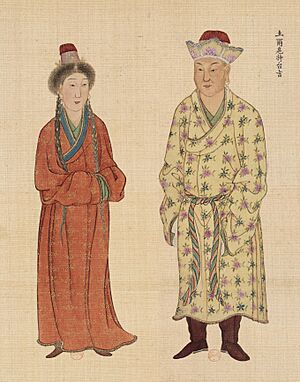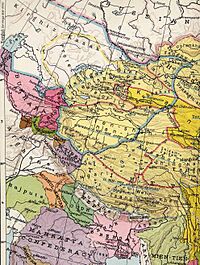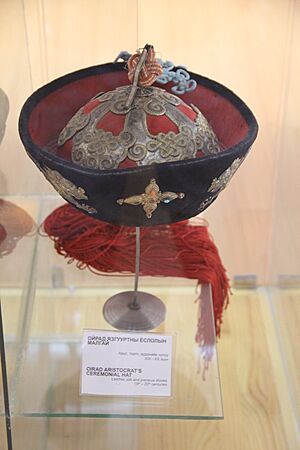Oirats facts for kids
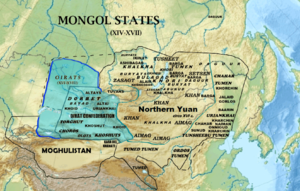
The location of the Four Oirat
|
|
| Total population | |
|---|---|
| 655,372 | |
| Regions with significant populations | |
(mainly in Xinjiang) |
250,000 (2013 estimate) |
| 205,000 (2010 census) | |
| 183,372 (2010 census) | |
| 12,000 (2018) | |
| Other | 5,000 (2020) |
| Languages | |
| Mainly: Oirat, Russian, other Mongolian languages Regional: Chinese |
|
| Religion | |
| Tibetan Buddhism, Mongolian shamanism, Islam | |
| Related ethnic groups | |
| Kalmyks and other Mongol peoples, Tuvans | |
The Oirats (also called Oirds) are a group of Mongols who originally lived in the Altai Mountains region. This area is found in parts of Siberia, Xinjiang (China), and western Mongolia. They are the westernmost branch of the Mongol people.
The first time the names "Elut" and "Yelut" were written down was in the 6th century. Historically, the Oirats were made up of four main tribes: the Dzungar (or Olots), Torghut, Dörbet, and Khoshut. Today, the Kalmyks who live near the Caspian Sea in Europe are also Oirats.
Contents
What's in a Name? The Meaning of Oirat
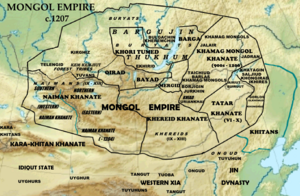
The name "Oirat" might come from two Mongolian words. One idea is that it means "forest people." This is because they were known as "forest people" in the 13th century.
Another idea is that the name comes from the Mongolian word oirt, which means "close" or "nearer ones."
The name Oirat might also come from Dörben Öörd, which means "The Allied Four." This refers to the four main tribes that formed their alliance.
Clear Script: The Oirat Writing System
In the 1600s, a monk named Zaya Pandita created a new writing system for the Oirats. It was called the Clear Script. He based it on an older Mongolian script.
The Clear Script was designed to be very clear and easy to read. It helped prevent mistakes and showed the differences between the Oirat language and other Mongolian languages.
This script was used in Kalmykia until the 1920s. Then, it was replaced by the Latin alphabet and later the Cyrillic script. In Mongolia, it was also replaced by Cyrillic in 1941. However, some Oirats in China still use the Clear Script today.
Oirat History: A Journey Through Time
The Oirats share a lot of their history, culture, and language with the Eastern Mongols. Sometimes, they were even united under the same leader.
The main Oirat groups were the Khoshut, Choros (or Ölöt), Torghut, and Dörbet. Their western neighbors, the Turkic peoples, sometimes called them "Kalmyk" or "Kalmak." This word means "remnant" or "to remain." It might refer to the Kalmyks staying Buddhist instead of becoming Muslim.
After the Yuan dynasty fell in China, the Oirats and Eastern Mongols started to see themselves as separate groups. The Oirats called themselves "Four Oirats."
Early Oirat History
One of the first times the Oirats are mentioned is in Secret History of the Mongols. This is a 13th-century book about Genghis Khan. The book says the Oirats were "forest people" led by a shaman-chief. They lived in areas that are now Tuva and Khövsgöl Province in Mongolia.
At first, the Oirats fought against Genghis Khan. Their chief, Qutuqa Beki, even tried to use a "thunder stone" to create a storm against Genghis's army! But the storm blew back at him. After being defeated, the Oirats joined Genghis Khan.
They became a strong and loyal part of the Mongol army. In 1207, Genghis Khan's son, Jochi, took control of the forest tribes, including the Oirats. Important Oirats, like Arghun Agha, served in the Mongol Empire.
Later, some Oirats joined Hulagu Khan's army and traveled to the Middle East. They even helped in the attack on Baghdad in 1258.
After the Yuan dynasty was pushed out of China, the Oirats formed a new alliance of their four main tribes. They grew stronger in the Altai Mountains and began to expand their lands. They hoped to bring all Mongols back under one rule.
The most famous Oirat ruler was Esen Taishi. He led the Oirats from 1438 to 1454. During this time, he united all of Mongolia. In 1449, Esen Taishi invaded Ming China. He defeated the Ming army and even captured the Chinese emperor! He later returned the emperor. After Esen tried to become Khan (a title usually only for Genghis Khan's family), he was killed, and Oirat power weakened.
For many years, from the 1300s to the mid-1700s, the Oirats often fought with the Eastern Mongols.
The Khoshut Khanate and Tibetan Buddhism
Around 1615, the Oirats became followers of Tibetan Buddhism. Soon after, they got involved in a religious conflict in Tibet. In 1637, Güshi Khan, a leader of the Khoshut Oirats, helped the Gelug school of Buddhism. He defeated their rivals and took control of Tibet in the 1640s. The 5th Dalai Lama then named Güshi Khan the Khan of Tibet.
In 1717, the Dzungars (another Oirat group) invaded Tibet and defeated the Khoshut Khanate. However, the Qing Empire of China later defeated the Dzungars in the 1750s. The Qing then took control of the Oirats and Tibet.
The Dzungar Khanate: A Powerful Empire
The 1600s saw the rise of another strong Oirat empire called the Dzungar Khanate. It stretched from the Great Wall of China to parts of modern-day Kazakhstan and Kyrgyzstan, and even into southern Siberia. This was the last big empire of nomadic people.
The Dzungars were very advanced for their time. They learned to make their own gunpowder weapons. They also developed a mixed economy, combining farming with herding. They even had mining and manufacturing industries. The Dzungars worked to make the Oirat language widely used in their empire.
Sadly, when the Manchu Qing Empire conquered Dzungaria in the 1750s, many Dzungar people were lost due to wars and sickness.
The Kalmyks: A Long Journey West

The Kalmyks are Oirats who live on the Caspian steppe in Europe. Their story in this region goes back a long way.
In the early 1600s, leaders like Kho Orlok led many Torghut Oirats (about 200,000–250,000 people) west to the Volga River. They were looking for new pastures for their animals. Here, they created the Kalmyk Khanate. They pushed out the local Nogai Horde and became powerful in the region.
The Kalmyks became allies with Russia, helping to protect Russia's southern borders. But over time, Russia slowly took more control. Russian and German settlers moved onto Kalmyk lands, and the Russian Orthodox church tried to get the Buddhist Kalmyks to change their religion.
In 1771, because of this pressure, a large group of Kalmyks (around 170,000 people) decided to migrate back to Dzungaria. Their leader, Ubashi Khan, hoped to bring back the Dzungar Khanate and Mongol independence. However, the Russian Empress Catherine the Great ordered her army to stop them. The journey was incredibly difficult, with attacks from other groups like the Kazakhs. After seven months, only about a third of the group reached Dzungaria. The Kalmyks who stayed on the west bank of the Volga could not cross the river and were forced to remain in Russia.
After the Russian Revolution, the Kalmyks faced more hardships. In the 1920s, a terrible famine caused many deaths. Some Kalmyks tried to move to Mongolia, but the Russian government stopped them. There were also revolts against Russia.
In 1943, during World War II, the entire Kalmyk population (about 120,000 people) was forced to move to Siberia by Stalin. They were accused of helping the invading armies. Many people suffered and died during this forced relocation. They were not allowed to return home until 1957. The Russian government also stopped the teaching of the Kalmyk language during this time.
Today, Kalmyks are working to bring back their language and religion, but the Russian language is still very common.
Oirats in China and Kyrgyzstan
Many Oirats also live in Xinjiang, China. They are mostly descendants of the Torghut and Khoshut tribes who returned from Kalmykia, and some Chahar Mongols who were soldiers there. The Chinese emperor even built a smaller copy of the Potala Palace to welcome them back.
Some Oirats who returned from Kalmykia did not go all the way to China. They settled near Lake Issyk-kul in present-day Kyrgyzstan and became Muslims.
There are also Oirats called Alasha Mongols who live near Gansu in China. They moved there in the late 1600s. Another group, the Ejine Mongols, live along the Ejin River. They are descendants of a Torghut leader from the Volga River.
Oirat Culture
The Oirats have a rich culture, including traditional folk songs like "Bumburjan." Their nomadic lifestyle has shaped their customs, clothing, and music over centuries.
Oirat Tribes
Here are some of the main Oirat tribes and groups:
- Altai Uriankhai
- Baatud
- Bayads
- Chantuu
- Choros
- Dorbet
- Khoshut
- Khoid
- Khotons
- Kalmyks
- Myangad
- Olots
- Sart Kalmyks
- Torghut
- Zakhchin
Images for kids
See also
- Demographics of Mongolia
- Four Oirats
- Kalmyk people
- Dzungar
- Kalmykia
- Altay people
- Al-Adil Kitbugha (Oirat Sultan of Egypt)




